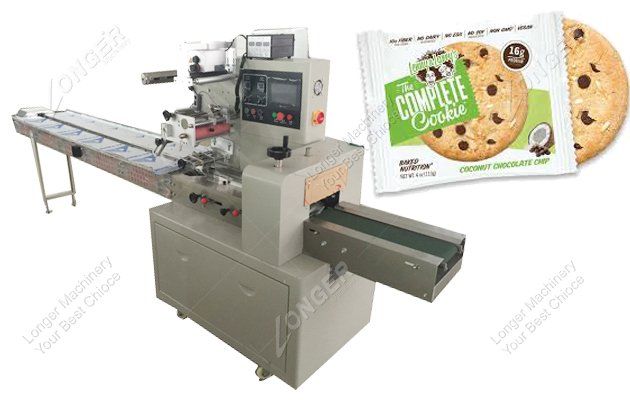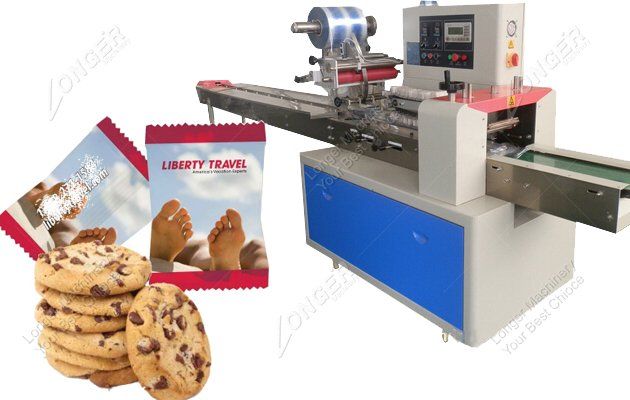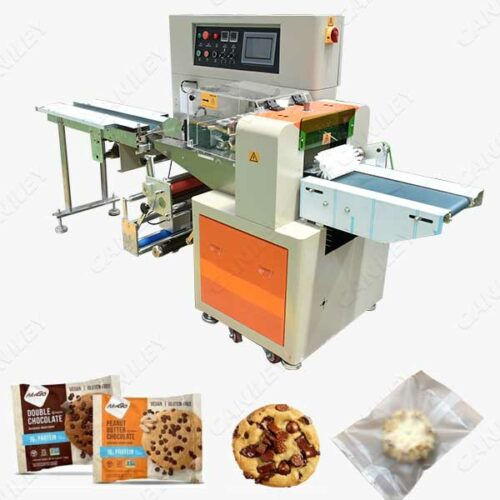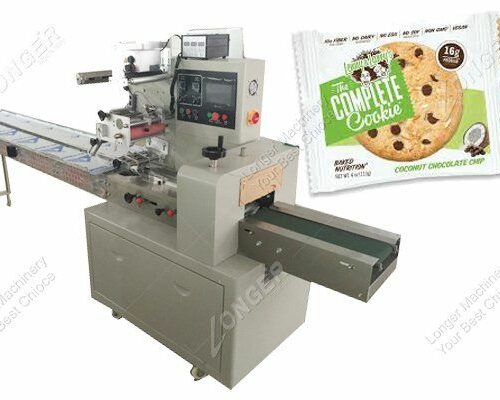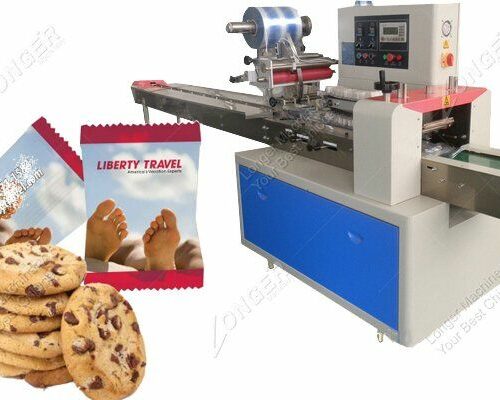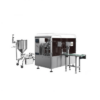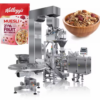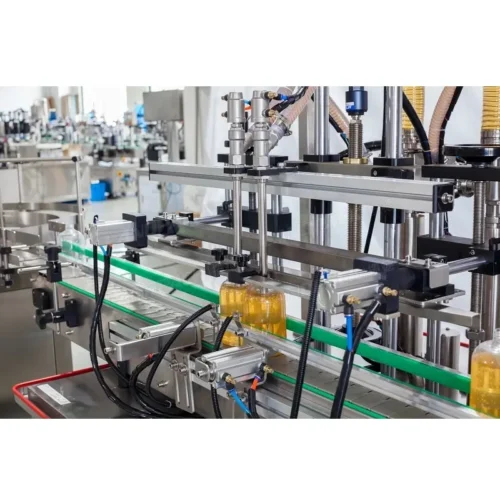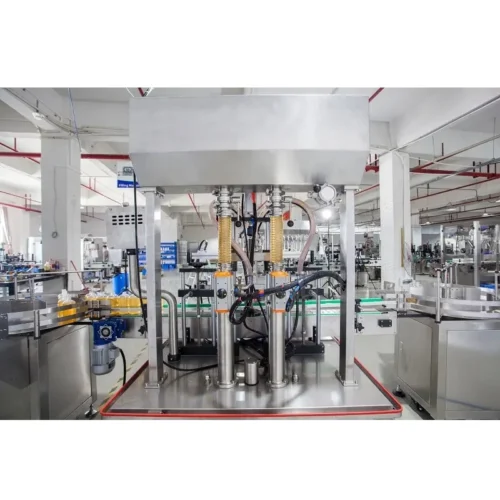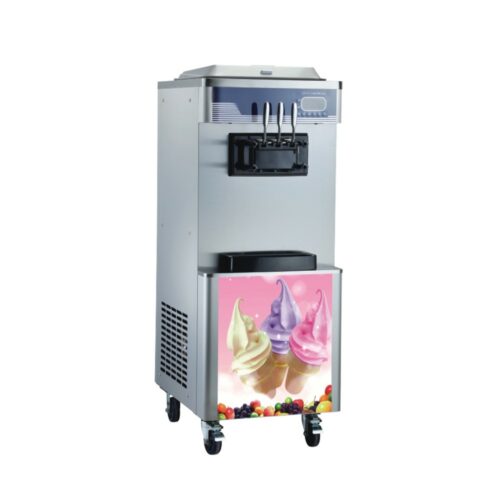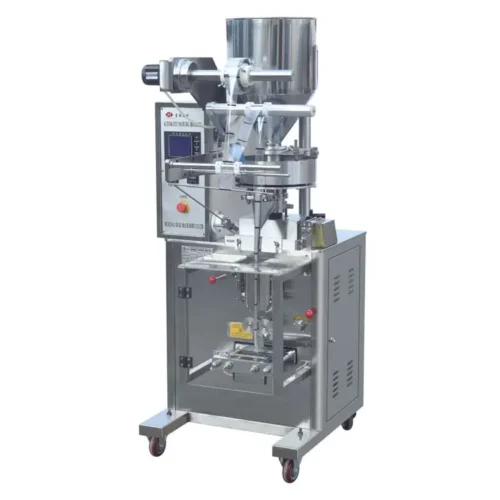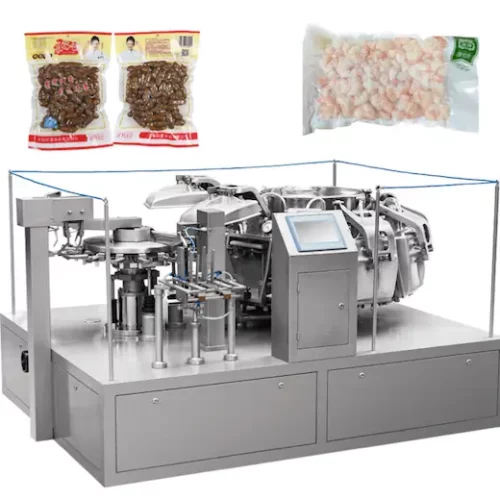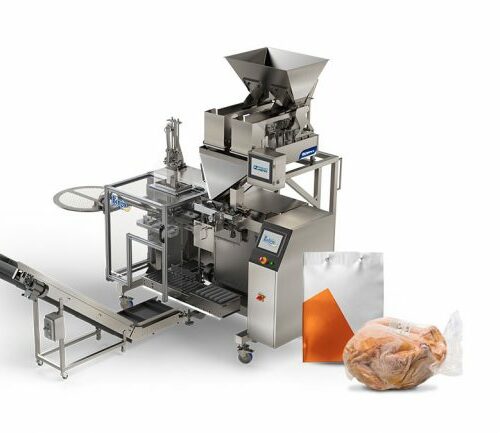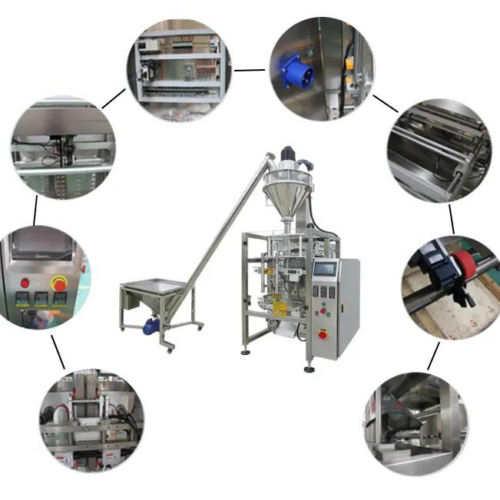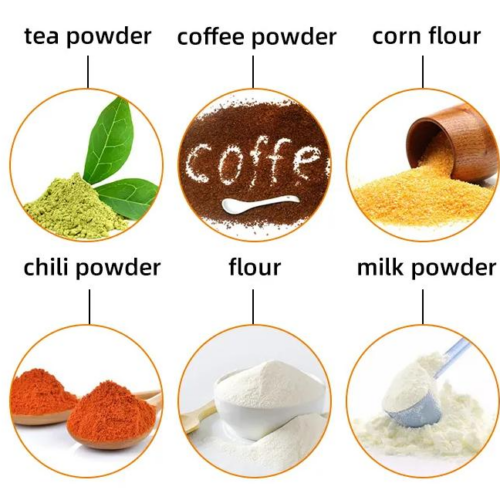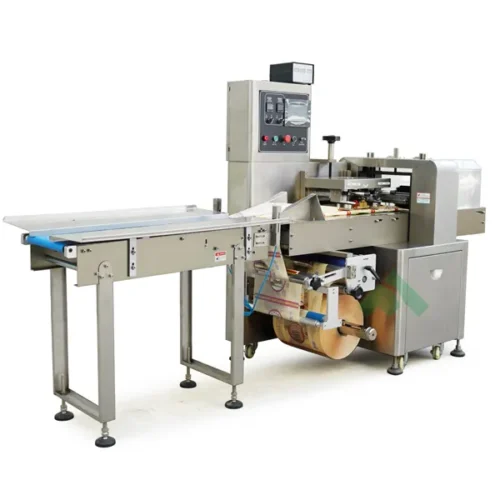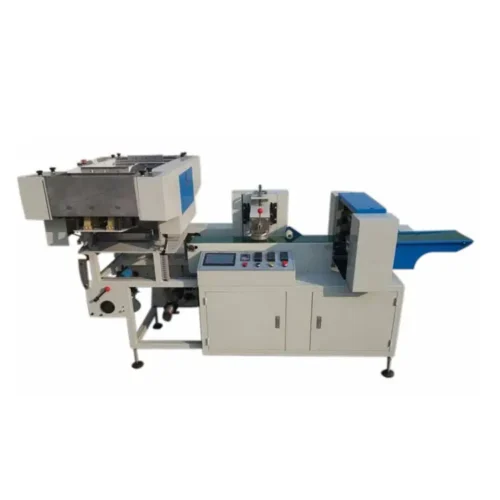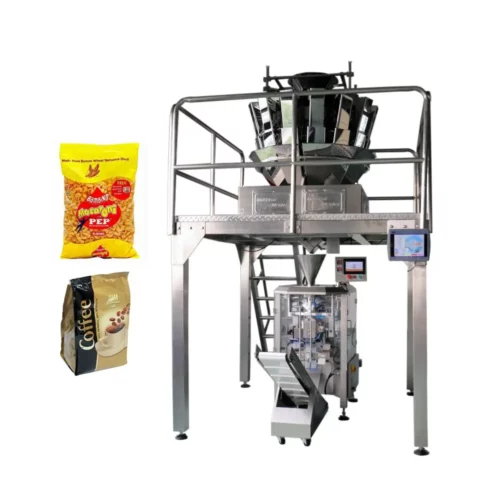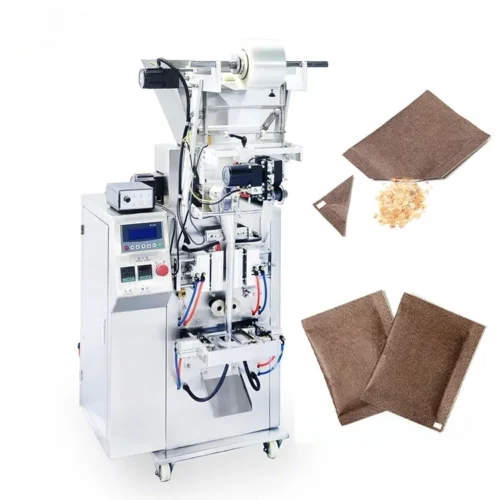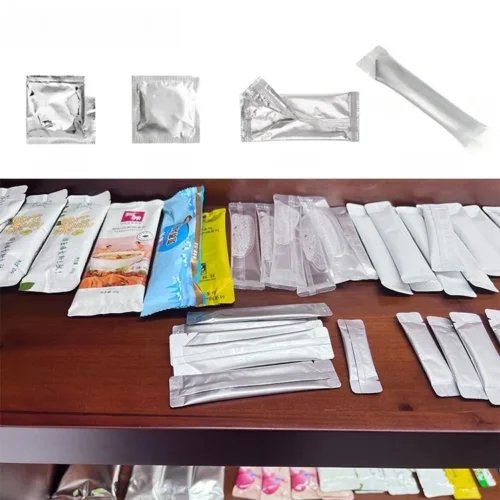Sure! Here are some key technical parameters often associated with cookie packaging machines:
1. Speed:
– Packaging Rate: Typically measured in packages per minute (PPM), ranging from 30 to 200 PPM depending on the model and configuration.
2. Packaging Material:
– Film Type: Compatible with various materials such as polyethylene, polypropylene, laminated films, and paper.
– Film Thickness: Ranges from 30 to 100 microns.
3. Machine Dimensions:
– Length, Width, and Height: Specific to each model, generally ranging from 1.5 to 4 meters in length, 1 to 2 meters in width, and 1.5 to 2.5 meters in height.
4. Weight:
- Can vary widely, typically between 500 to 2000 kilograms.
5. Electrical Specifications:
– Power Supply: Generally 220V or 380V, 50/60 Hz.
– Power Consumption: Ranges from 2 to 5 kW.
6. Control System:
– User Interface: Touchscreen display, PLC controlled.
– Automation Level: Fully-automatic or semi-automatic.
7. Sealing Type:
– Heat Sealing Mechanisms: Options include both horizontal and vertical sealing.
8. Product Dimensions:
- Can accommodate a variety of cookie sizes, with width and height adjustable settings.
9. Feeding System:
– Product Feeding Type: Options include manual or automatic infeed systems, with possibilities for integration with conveyors or robotic arms.
10. Bag Dimensions:
– Length: Adjustable, ranging from 50 to 300 mm.
– Width: Adjustable, from 50 to 200 mm.
11. Environmental Conditions:
- Suitable for operating temperatures between 0 and 40 °C.
- Humidity range from 20% to 90% RH.
12. Material Contact Parts:
- Made from food-grade stainless steel (usually SS304 or SS316).
13. Ancillary Features:
– Date Coding: Integration of date batch coding systems.
– Gas Flushing: Optional systems for modified atmosphere packaging.
These parameters are critical for choosing the right cookie packaging machine based on production requirements, environmental conditions, and specific operational needs.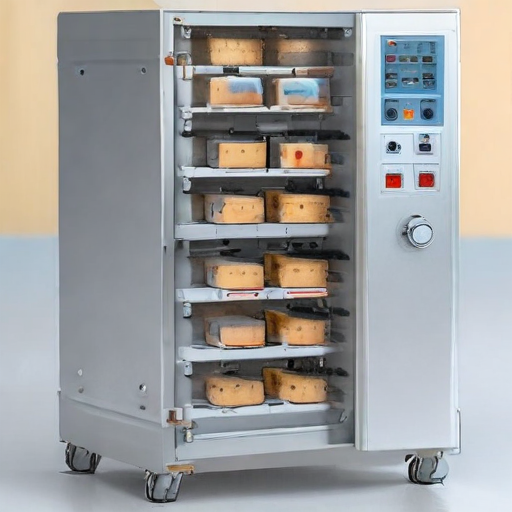
A cookie packaging machine is an essential piece of equipment in the food processing industry, designed to efficiently package cookies while maintaining their freshness and quality. Here are the key features of a cookie packaging machine:
1. High-Speed Operation: Capable of packaging a large number of cookies per minute, significantly increasing production efficiency.
2. Automatic Feeding System: Equipped with an automated system to feed cookies into the machine seamlessly, reducing manual handling and labor costs.
3. Versatile Packaging Options: Supports various packaging types, such as pillow bags, gusseted bags, and stand-up pouches, catering to diverse market demands.
4. Precision Weighing and Portioning: Integrated weighing systems ensure accurate portioning, minimizing product wastage and ensuring consistency.
5. User-Friendly Interface: Features an intuitive touchscreen control panel for easy operation, adjustment, and monitoring of the machine’s parameters.
6. Hygienic Design: Constructed with food-grade stainless steel and designed to be easy to clean, ensuring compliance with food safety standards.
7. Sealing Efficiency: Advanced sealing mechanisms provide airtight seals, preserving the freshness and extending the shelf life of the cookies.
8. Customization Capabilities: Allows for adjustments in packaging size and form to meet specific customer requirements and packaging designs.
9. Error Detection and Alarming: Equipped with sensors and alarms to detect packaging errors, ensuring quality control and reducing downtime.
10. Compact Design: Space-efficient design suitable for various production environments, including small and medium-sized operations.
11. Energy Efficiency: Engineered to use minimal power, reducing operational costs and environmental impact.
12. Integration with Upstream and Downstream Equipment: Easily integrates with other production line equipment, such as conveyors, cooling tunnels, and carton packing machines, for a seamless production process.
13. Durability and Reliability: Built with robust materials to ensure long-term operation with minimal maintenance requirements.
14. Safety Features: Equipped with safety guards and emergency stop functions to protect operators and ensure safe working conditions.
These features make the cookie packaging machine an indispensable tool for efficient, reliable, and high-quality cookie packaging.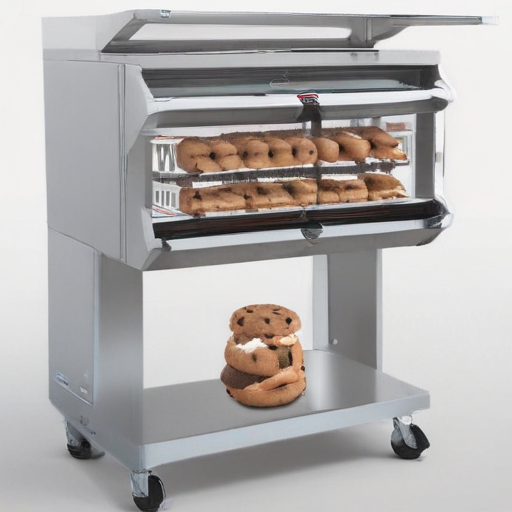
A cookie packaging machine is a specialized piece of equipment designed to automate the process of packaging cookies. Its applications span various industries and market segments, enhancing efficiency, consistency, and product protection. Below are key applications of a cookie packaging machine:
1. Food Manufacturing Plants: In large-scale cookie production facilities, these machines streamline the packaging process, allowing for high-speed, high-volume output. This reduces labor costs and ensures uniformity across all packaged products.
2. Bakeries: Medium-sized and artisan bakeries use cookie packaging machines to maintain product freshness and extend shelf life. Automated packaging protects cookies from environmental factors and contamination.
3. Retail Industry: Supermarkets and retail stores benefit from cookie packaging machines to prepare bulk cookies for individual sale. Proper packaging enables easy handling and attractive presentation, improving shelf appeal.
4. E-commerce: For businesses selling cookies online, efficient packaging is essential. These machines ensure that cookies are securely packaged to withstand transportation, thereby maintaining quality upon arrival.
5. Café Chains and Independent Cafés: Small to medium-sized cafés use cookie packaging machines to pre-package cookies for quick sale. This enhances speed of service and maintains a consistent product offering.
6. Corporate Gifting and Events: Companies providing cookies for corporate gifts or events can use packaging machines to handle large quantities efficiently, ensuring professional presentation and compliance with health standards.
7. Custom and Seasonal Products: For seasonal or themed cookie products, packaging machines can be adjusted for varying designs, shapes, and sizes, accommodating special promotional runs or holiday-themed assortments.
8. Health and Safety Compliance: Packaging machines help in adhering to health and safety regulations by minimizing human contact with food products, reducing the risk of contamination and ensuring hygiene standards are met.
9. Reduced Waste and Sustainability: Modern cookie packaging machines are often designed to minimize material waste. Efficient packaging contributes to sustainable practices and reduces the carbon footprint of the production process.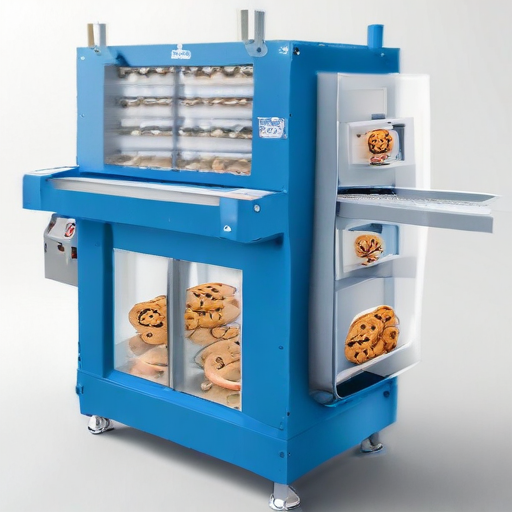
Certainly! Here are various types of cookie packaging machines, designed to meet different packaging needs:
1. Horizontal Flow Wrappers:
– Flow Wrap Machines: Ideal for individual or multi-cookie packs. They wrap cookies in a continuous film tube, sealing the ends.
– High-Speed Flow Wrappers: For high-demand environments, offering greater speed and efficiency.
2. Vertical Form Fill Seal (VFFS) Machines:
- These machines form a pouch from a flat roll of film, fill it with cookies, and seal it. Suitable for bulk and individual packaging.
3. Tray Sealing Machines:
– Manual/Electric Tray Sealers: For smaller operations, manually placing trays and sealing them.
– Automatic Tray Sealers: High-efficiency machines for large-scale operations, with automatic loading and sealing.
4. Vacuum Packaging Machines:
- Maintains cookie freshness by removing air from the packaging before sealing. Suitable for long-term storage.
5. Thermoforming Machines:
- Create cookie packages from plastic sheets, typically used for blister packs or clam-shell packaging.
6. Cartoning Machines:
– End Load Cartoners: Cookies are loaded from the side into pre-glued cartons.
– Top Load Cartoners: Load cookies from the top and seal the carton.
7. Biscuit Packaging Systems:
- Specialized for handling delicate or shaped cookies. They coordinate wrapping, sealing, and sometimes even boxing.
8. Multipack Wrapping Machines:
- Bundle several individual packages into one larger pack, often used for retail environments.
9. Pouch Packaging Machines:
– Pre-made Pouch Fill and Seal Machines: Load cookies into pre-made pouches and seal them.
– Stand-up Pouch Machines: Create stand-up pouches, providing more shelf appeal.
10. Shrink Wrapping Machines:
- Encase cookies in shrink film and use heat to shrink the film around the product, providing a tight, secure package.
11. Robotic Packaging Systems:
- Integrate robotic arms for precise and flexible cookie handling and packaging, enhancing efficiency and adaptability.
These machines vary in capacity, automation level, and packaging type. Selecting the right machine depends on production volume, packaging style, and cookie type.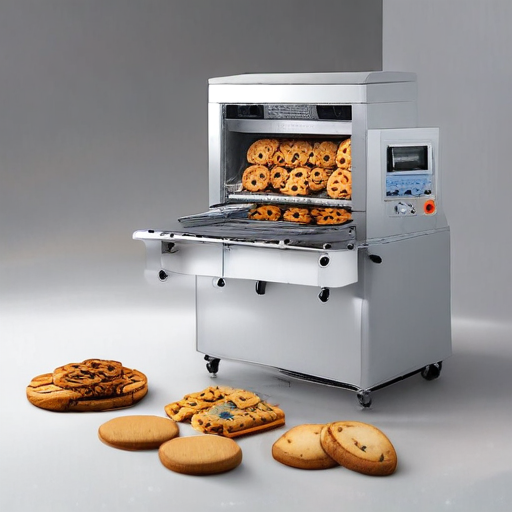
When considering custom manufacturing options for a cookie packaging machine, several key factors can be tailored to meet your specific needs:
1. Machine Size and Capacity:
– Small-scale: Compact machines for home-based businesses or small bakeries with lower output.
– Industrial-scale: Larger machines designed for factories, capable of handling high volume production.
2. Packaging Type:
– Flow Wrapping: Sealing cookies in plastic or metalized film for freshness.
– Tray Sealing: Placing cookies in preformed trays, then sealing with film.
– Box Packaging: Automated boxing of cookies for premium presentation.
3. Flexibility in Size and Shape:
- Adjustable settings to handle different sizes and shapes of cookies—round, rectangular, or custom shapes.
4. Automation Level:
– Semi-automatic: Basic automation for businesses that require some manual oversight.
– Fully automatic: Complete automation, reducing labor costs and increasing efficiency.
5. Material Handling:
- Options for delicate handling mechanisms to ensure cookies are not damaged during packaging.
6. Speed and Output:
- Customizable according to required output per hour/day, adjustable speed settings based on production needs.
7. Customization of Printing and Labeling:
- Integrated printers for adding dates, batch numbers, and even branding directly onto the packaging.
8. Integration with Other Systems:
- Compatibility with existing production lines, such as mixers, ovens, and conveyors.
9. Sustainability:
- Options for eco-friendly packaging materials and energy-efficient machine operations.
10. Compliance and Safety:
- Ensuring the machine complies with local and international food safety standards.
Tailoring a cookie packaging machine to your specific needs can result in increased efficiency, reduced waste, and improved product quality, all contributing to a more successful business operation.
Quality Control of Cookie Packaging Machine:
1. Material Inspection:
- Verify the quality of raw materials and components.
- Use certified suppliers and conduct random sampling.
2. Assembly Line Monitoring:
- Ensure alignment and assembly follow engineering designs.
- Conduct in-process inspections to detect defects early on.
3. Electrical and Mechanical Testing:
- Check all electrical wiring and connections.
- Test mechanical parts for functionality and safety.
4. Calibration:
- Adjust sensors, weight checkers, and sealing mechanisms to meet precise standards.
5. Performance Testing:
- Run the machine under various simulated operational conditions.
- Monitor for consistency in speed, packaging accuracy, and defect rates.
6. Final Inspection:
- Conduct a thorough review of the assembled machine.
- Ensure compliance with industry standards and customer specifications.
7. Documentation:
- Maintain records of all inspections, tests, and materials for traceability.
Manufacturing Process of Cookie Packaging Machine:
1. Design and Prototyping:
- Develop detailed designs using CAD software.
- Create a prototype to test functionalities.
2. Material Sourcing:
- Procure quality materials and components like stainless steel, motors, and sensors.
3. Machining and Fabrication:
- Cut and shape components using CNC machines.
- Perform welding, drilling, and other fabrication processes.
4. Sub-assembly:
- Assemble parts into sub-units such as conveyor belts, sealing units, and control panels.
5. Main Assembly:
- Integrate sub-assemblies into the main framework.
- Ensure proper alignment and connection of all parts.
6. Integration of Electronics:
- Install wiring, sensors, and control systems.
- Program the PLC (Programmable Logic Controller) for automated operations.
7. Quality Control Checks:
- Conduct rigorous testing and inspections at different stages.
- Resolve any issues found during testing.
8. Finishing:
- Apply surface treatments to prevent corrosion.
- Attach labels, safety notices, and brand decals.
9. Packaging and Delivery:
- Securely pack the machine for transport.
- Ensure all manuals and necessary documentation are included.
Each step in the process is crucial to maintain the high standards required for a reliable and efficient cookie packaging machine.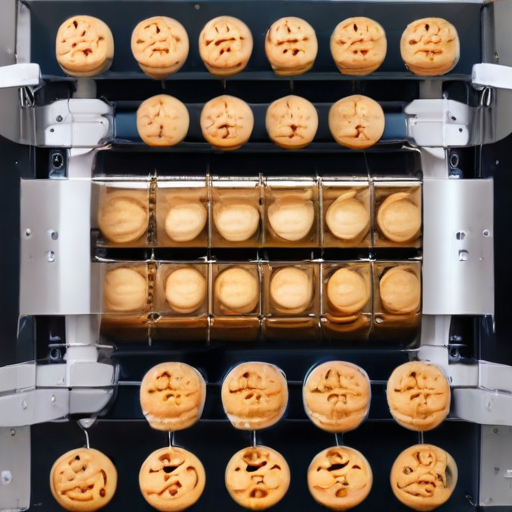
Using a cookie packaging machine is a straightforward process, but it requires attention to detail. Here’s a concise guide to help you:
Setup:
1. Read Manual: Start by thoroughly reading the user manual specific to your machine model.
2. Clean: Ensure the machine and the work area are clean and sanitized.
3. Plug In: Connect the machine to a power source.
4. Load Packaging Material: Place the packaging film or bags onto the designated holder and thread it through the machine’s guides as instructed.
Operation:
1. Power On: Switch on the machine.
2. Settings Configuration: Adjust settings such as temperature, speed, and packaging dimensions according to the type and size of cookies.
3. Feed Cookies: Place the cookies onto the feeding conveyor or tray.
4. Align: Ensure cookies are properly aligned for smooth packaging.
5. Initiate Packaging: Press the start button to begin the packaging process.
Monitoring:
1. Supervise: Stay vigilant, watching for jams or misalignments.
2. Adjustments: Make real-time adjustments if necessary to ensure smooth operation.
Post-Operation:
1. Turn Off: After the packaging is complete, switch off the machine.
2. Clean: Clean the machine to remove crumbs or any food particles.
3. Maintenance: Perform regular maintenance checks, lubricate moving parts, and replace any worn-out components as per the manual.
Safety Tips:
– Training: Ensure operators are properly trained.
– Emergency Stop: Familiarize yourself with the emergency stop button.
– Avoid Distractions: Do not leave the machine unattended while in operation.
Conclusion:
Using a cookie packaging machine involves preparation, careful operation, monitoring, and maintenance. By adhering to these steps, you ensure consistent, efficient, and safe packaging of cookies.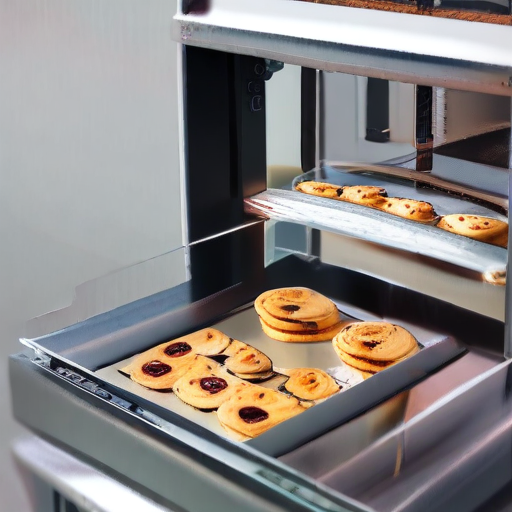
Properties of a Cookie Packaging Machine:
1. Automated Operation: Streamlines the packaging process, increasing efficiency and reducing labor costs.
2. Versatility: Capable of handling various cookie shapes, sizes, and types, including soft, hard, and sandwich cookies.
3. Speed: High-speed operation, often packaging hundreds or thousands of cookies per minute.
4. Precision: Accurate cookie count, weight, and placement to ensure consistent quality.
5. Sealing Options: Different sealing methods such as heat sealing, ultrasonic sealing, or vacuum packing to prolong shelf life.
6. Material Compatibility: Supports various packaging materials like plastic films, foil, and paper.
7. Hygiene: Designed with food-grade materials and easy-to-clean components to meet sanitary standards.
8. Modular Design: Offers flexibility to add or remove components based on specific needs.
9. User Interface: Intuitive control panels or touch screens for easy operation and monitoring.
10. Safety Features: Equipped with emergency stops, overload protection, and safeguarding measures to protect operators.
Terms Related to a Cookie Packaging Machine:
1. Flow Wrapper: A common type of machine used for horizontal form-fill-seal processes.
2. Vertical Form-Fill-Seal (VFFS): Another packaging type where the package is made from a flat roll of film in a vertical configuration.
3. Multihead Weigher: An advanced weighing machine used to ensure accurate weights of cookies before packaging.
4. Conveyor System: Mechanical systems that transport cookies through different stages of the packaging process.
5. Film Roll: The material used to wrap cookies, typically made of plastic or foil.
6. Sealing Jaw: The mechanism that seals the packaging material.
7. Cutting Device: Equipment that cuts the packaging material to form individual packs.
8. Coding Machine: Prints dates, barcodes, or batch numbers on the packaging.
9. PLC (Programmable Logic Controller): Controls the machine operations, ensuring precision and efficiency.
10. Servo Motor: Provides precise control of the machine’s movements, enhancing accuracy.
These properties and terms help in understanding the functionalities and technical aspects of cookie packaging machines, ensuring optimal performance and quality in the packaging process.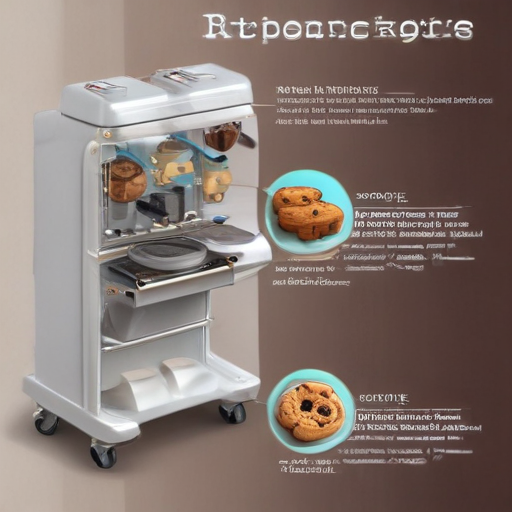
The evolution of the cookie packaging machine reflects broader trends in industrial automation and technological advancements:
Early 20th Century: The inception of cookie packaging machines began in the early 1900s. Initial efforts were rudimentary, relying heavily on manual labor with hand-operated machines for wrapping and sealing cookies. Early machines focused on basic protection from contamination and extended storage.
Mid 20th Century: Post World War II, mechanization saw significant strides. The introduction of semi-automated machines allowed for higher production rates. Manual handling was reduced, and manufacturers could offer consistent packaging quality. The use of cellophane as a wrapping material became common, providing better moisture resistance.
1970s-1980s: With the advent of computer technology, packaging machines became more sophisticated. Automated systems with programmable logic controllers (PLCs) emerged, enhancing precision and reducing human intervention. Innovations like flow wrapping and vacuum packaging were integrated, boosting the shelf life and visual appeal of cookie packages.
1990s: The rise of robotics and improved sensors led to even greater automation. Machines could now handle a variety of packaging styles, including trays, pouches, and cartons, with minimal human supervision. The focus expanded to include not just functionality but also environmental sustainability, with machines optimized for reduced waste and recyclable materials.
2000s: Enhanced digital controls and the introduction of Industry 4.0 concepts further revolutionized the field. Real-time monitoring, data analysis, and predictive maintenance became standard features. Machines were designed for higher flexibility and quicker changeovers to accommodate varying batch sizes and packaging designs.
2010s-Present: Modern cookie packaging machines incorporate advanced robotics, artificial intelligence, and machine learning to optimize performance, quality checks, and customization. Sustainability remains a key concern, with the development of biodegradable packaging materials and energy-efficient machines.
Through these stages, cookie packaging machines transformed from simple, manual devices to complex, automated systems, embodying the advancements in technology and industry practices.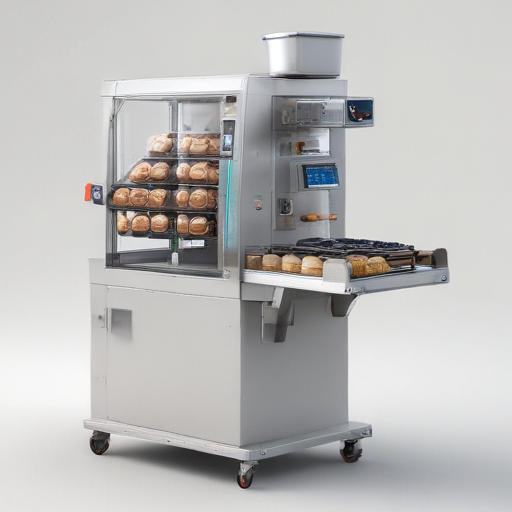
Selecting a reliable cookie packaging machine involves several key considerations to ensure efficiency, product quality, and long-term reliability. Here’s a concise guide to help you make an informed decision:
1. Identify Your Needs:
– Production Volume: Determine the quantity of cookies you need to package daily. This will help you choose a machine with suitable speed and capacity.
– Package Type: Decide on the type of packaging—e.g., bags, boxes, or pouches—and ensure the machine can handle your specific requirements.
2. Machine Features and Specifications:
– Speed and Efficiency: Look for a machine that aligns with your production speed requirements without compromising quality.
– Versatility: A machine capable of handling various package sizes and materials can offer greater flexibility.
– Automation Level: Depending on your budget and production scale, decide between semi-automatic and fully automatic machines.
3. Quality and Durability:
– Build Material: Machines made from high-quality, durable materials (like stainless steel) ensure longevity and hygiene.
– Brand Reputation: Choose reputable manufacturers with positive customer feedback and reliable after-sales service.
4. Ease of Use and Maintenance:
– User Interface: Ensure the machine has an intuitive control panel that is easy to operate.
– Maintenance Requirements: Opt for a machine with low maintenance needs and readily available spare parts.
5. Compliance and Certifications:
– Safety Standards: Verify that the machine complies with relevant safety and hygiene standards (e.g., FDA, CE).
– Energy Efficiency: Check for energy-efficient models to reduce operational costs.
6. Cost Considerations:
– Budget: Compare prices, but avoid compromising on essential features and reliability for a lower cost.
– Total Cost of Ownership: Consider long-term costs, including maintenance, spare parts, and electricity consumption.
7. Trial and Demonstration:
– Demo: If possible, see a live demonstration or a trial run with your products to assess the machine’s performance.
By thoroughly evaluating these factors, you can select a reliable cookie packaging machine that meets your production needs and ensures consistent quality.
Cookie Packaging Machine FAQ
-
What is a cookie packaging machine?
A cookie packaging machine automates the process of packaging cookies into various forms like bags, boxes, or trays, ensuring consistent quality and efficiency. -
What types of cookies can be packaged?
Versatile models can handle different types of cookies including soft, hard, filled, and sandwich cookies. -
How fast can a cookie packaging machine operate?
Speed ranges from 50 to 300 packages per minute, depending on the machine model and packaging type. -
What kinds of packaging materials can be used?
Common materials include plastic films, aluminum foils, paper-based materials, and laminates. -
Is the machine easy to integrate into an existing production line?
Most modern machines are designed for easy integration and can be customized to fit specific production requirements. -
How is the machine cleaned and maintained?
Machines typically feature easy-to-clean designs, with accessible parts and materials that permit regular, straightforward cleaning protocols. -
Can the machine handle irregularly shaped cookies?
Advanced models with adjustable settings can accommodate various shapes and sizes, including irregularly shaped cookies. -
Are there options for customization?
Yes, machines often offer customization options for different packaging styles, sizes, and branding elements. -
What is the cost of a cookie packaging machine?
Prices vary greatly based on capabilities, ranging from $10,000 for basic models to over $100,000 for high-end, fully automated systems. -
What kind of training is required to operate the machine?
Manufacturers usually provide training sessions; basic operational knowledge and routine maintenance skills are generally sufficient. -
Is technical support available?
Reputable manufacturers offer after-sales support including technical assistance and spare parts supply. -
Can the machine perform quality control?
Some advanced models integrate quality control features like weight checking, metal detection, and sealing integrity testing. -
What is the typical lead time for delivery?
Delivery times can range from a few weeks to several months, depending on customization and manufacturing schedules.
Understanding these FAQs can help in selecting the right cookie packaging machine tailored to your production needs.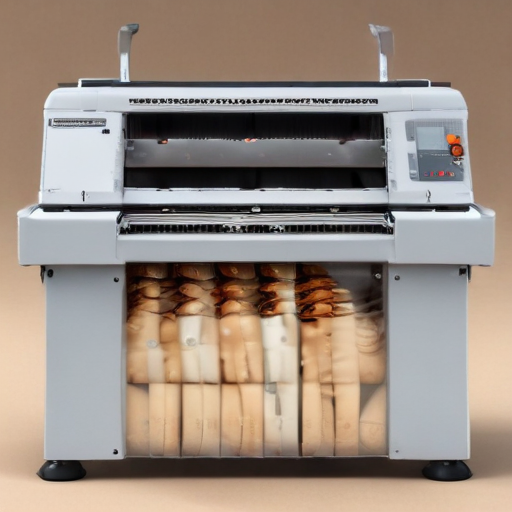
1. What types of cookie packaging machines are available?
There are flow wrap machines, vertical form-fill-seal machines, and tray sealing machines. Each has unique capabilities suited for different packaging requirements.
-
How do I choose the right machine for my needs?
Evaluate factors like the type of cookies, production speed, packaging materials, and budget. Consulting with suppliers about your specific needs can also help in making an informed decision. -
What is the average lead time for delivery?
Lead times can vary, but typically it ranges from 30 to 60 days. Customizations can extend this period. -
Are these machines compliant with international safety standards?
Most reputable manufacturers ensure compliance with CE, ISO, and other international standards. Always verify certifications before purchase. -
What is the price range for these machines?
Prices can range from $10,000 to $100,000 or more, depending on the machine’s specifications, capabilities, and customization options. -
Can these machines handle different types of cookie packaging?
Yes, modern machines can be configured or adjusted to handle various packaging styles, sizes, and materials. -
How difficult is the installation process?
Most suppliers offer installation and training services. The complexity can vary, but generally, experienced technicians can complete installation in a few days. -
What kind of maintenance is required?
Regular maintenance includes cleaning, lubrication, and periodic parts replacement. Suppliers often provide a maintenance schedule and training. -
Is there after-sales support available?
Reputable suppliers provide after-sales support, including spare parts, technical support, and maintenance services. Ensure this is part of your agreement. -
How is shipping managed, and what are the costs involved?
Typically, the supplier handles shipping, but costs are borne by the buyer. Shipping costs depend on the machine size, weight, and destination.
These answers provide a concise overview for buyers sourcing cookie packaging machines from China, addressing common concerns and considerations.


